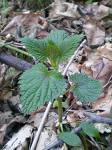Fall is far away – but I did do my first harvesting yesterday: I got my peas off the vine, just in time before they would have been overripe and hard. Did I mention that this year I started vegetable gardening in pots on the terrace? Because I have crammed the garden so much with flowers and berries that not a speck of free soil was anywhere.
The pods yielded about a cup of peas – just enough for the two of us. I sautéed them very shortly with dill and a tad of ghee (butterfat). As you might have noticed, I usually shun dairy. Most dishes improve when you substitute with olive oil but occasionally a recipe calls for butter, and then I use ghee. In butter fat the proteins are skimmed off the melted butter. Since dairy proteins are the main culprits when it comes to inflammation, of all dairy products, ghee is the safest. I am not a purist – at times, I give in to an emotional need for comfort food. So it was yesterday, with the peas.
From the store, we also had dinosaur kale (also called lacinato kale, Tuscan kale) which is a swell way to introduce kids to greens. The kale has this puckered surface which really looks like dinosaur skin - just don’t tell them yet that researchers now discuss if dinosaurs had feathers. A friend had brought me a first bulb of garlic including greens from her garden, and I threw this, cut, into the kale, and added olive oil, some more garlic, pepper, salt.
Served this with red lentils with cumin, and fish with a bit of left-over green sauce from the freezer.
With it, we drank our garden tea, made from stinging nettles, dandelions, mallow, mints, rosemary, sage, chives, a bit of a young burdock leaf, and just a snippet of wormwood (it is toxic in greater amounts).
A simple, everyday meal – but oh, how sumptuous! Read More
Blog: On Health. On Writing. On Life. On Everything.
A Tea From Your Garden
April 30, 2010
Green is the color of life, and green herbs keep us healthy.
From April to November, I find things growing in my garden that go into my daily garden tea. Only one question asked of that green thing: Is it edible? If it is not, forget it! If you don’t know, don’t even touch it – what you don’t know can kill you when you put it into your tea!
Today, this is what I gathered: Dandelion leaves and flowers, stinging nettle leaves, feverfew leaves, young burdock shoots. Pine needles (make sure you can identify them because hemlock and yew would be deadly!), rose leaves, raspberry leaves. And from my herb garden: rosemary, thyme, basil, parsley, chives (including their fat purple buds), sage, cilantro. I also started a vegetable garden in big pots on the terrace and I snipped off a few leaves off lettuce and broccoli.
These green things contain small molecules - phyto-nutrients - which we are not getting easily from our modern food. But our ancient bodies need them to function.
Nature gives me these green gifts every morning, and I breathe in the beauty of my garden (which is, admittedly, an unkempt jungle – but never touched by pesticides, herbicides, and the like!). When I come into the kitchen I feel as if I have meditated (I have meditated!). I throw my big handful of greens into a cup, pour boiling water over it and start my day in beauty, contemplation – and health.
And it tastes good, too. Read More
Spring Fatigue - Undiagnosed
April 19, 2010
A disease exists in Europe that is never diagnosed here: Spring fatigue. Around February, March, April everybody complains about it - and suffers.
Spring fatigue happens when the body is depleted of essential nutrients at the end of the winter, after not enough fresh fruit and vegetables in the cold months.
Do American people not have it? I think they do have spring fatigue - they are just not told about it. Because there is no pill against it. And the rather like to think they have spring fever...
Yet the remedy is easy: Eat about as many fresh greens you can put your hands on: chives (around this time I put handfuls of chives on and in about everything), dandelions, spring onions, stinging nettles, kale, chard, spinach. Many might be weeds in your garden.
Stinging nettles? Yes! It is a weed, but I planted it in my garden on purpose (in a raised bed). Yesterday, I made my first nettle soup of the season. The recipe is easy: Boil one or two cut potatoes (including skin) with a little bit of water and salt. When half soft, add stinging nettle leaves (the stems are tough; you need gloves to handle nettle because they sting), olive oil and pepper. Boil until soft - only a few more minutes. You can puree it - I did. But one can also just eat it like a green vegetable. Never forget the olive oil - without fat, your body cannot assimilate vitamin A from the greens.
Europeans think the stinging nettle is the most valuable herb, period. They use it for a tonic, strengthening the body overall. It is also good against hay fever, but you better buy it as phyto-caps for that purpose. The nettle root is used against prostatitis.
Make sure you know your herbs and harvest your herbs from a clean place - not where dogs pee on them. Go for a local herb walk to learn about herbs. Read More
